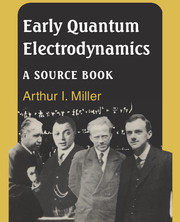Book contents
- Frontmatter
- Contents
- Preface
- Notes to the Preface
- Acknowledgements
- Notes to the Reader
- I Frame-setting essay
- Epilogue
- Notes
- References to the Frame-setting essay
- II Selected papers
- 1 The self-energy of the electron
- 2 Remarks on radiation theory
- 3 Theory of the positron
- 4 Discussion of the infinite distribution of electrons in the theory of the positron
- 5 The self-energy of the electron
- 6 Remarks on the Dirac theory of the positron
- 7 The quantization of the scalar relativistic wave equation
- 8 The electrodynamics of the vacuum based on the quantum theory of the electron
- 9 Theory of the emission of long-wave light quanta
- 10 The universal length appearing in the theory of elementary particles
- 11 The interaction between charged particles and the radiation field
- Index to Frame-setting essay
11 - The interaction between charged particles and the radiation field
Published online by Cambridge University Press: 05 August 2012
- Frontmatter
- Contents
- Preface
- Notes to the Preface
- Acknowledgements
- Notes to the Reader
- I Frame-setting essay
- Epilogue
- Notes
- References to the Frame-setting essay
- II Selected papers
- 1 The self-energy of the electron
- 2 Remarks on radiation theory
- 3 Theory of the positron
- 4 Discussion of the infinite distribution of electrons in the theory of the positron
- 5 The self-energy of the electron
- 6 Remarks on the Dirac theory of the positron
- 7 The quantization of the scalar relativistic wave equation
- 8 The electrodynamics of the vacuum based on the quantum theory of the electron
- 9 Theory of the emission of long-wave light quanta
- 10 The universal length appearing in the theory of elementary particles
- 11 The interaction between charged particles and the radiation field
- Index to Frame-setting essay
Summary
Nuovo Cimento NS, 15: 108–17, 1938. Presented at the Galvani Bicentenary Congress, Bologna, 18–21 October, 1937.
In a recent publication, I have developed the basic formulas of the quantum theory of the interaction between the radiation field and charged particles. This development was in a form that differs somewhat from the usual presentations in the literature. The most consistent of these presentations goes back to the fact that, in classical electron theory, equations of motion of charged, radiating particles with a finite size and the equations which refer to the electromagnetic field can be written in canonical form; nothing stands in the way of a formal quantization of these canonical equations. But what causes trouble is the fact that the concept of a radiating body contravenes the foundations of relativity theory. To this must be added that one encounters major and well-known difficulties if one investigates the transition to the limit where the extension of the particles tends to zero and where the electromagnetic mass increases more and more.
In the above-mentioned publication, I have tried to present the theory in such a fashion that the questions of the structure and the finite extension of the particles are not explicitly involved and that the quantity that is introduced as the ‘particle mass’ is from the very beginning the experimental mass. Indeed, I start from phenomena – and for the time being we speak purely classically – in which a charged particle moves in an external magnetic field and for which radiation and the radiation reaction can be neglected to a first approximation (quasi-stationary motion).
- Type
- Chapter
- Information
- Early Quantum ElectrodynamicsA Sourcebook, pp. 254 - 258Publisher: Cambridge University PressPrint publication year: 1994



